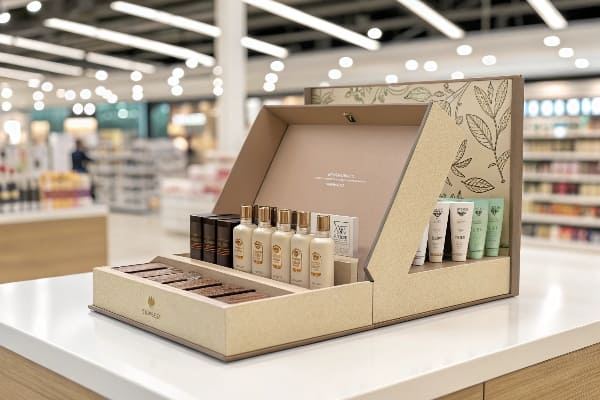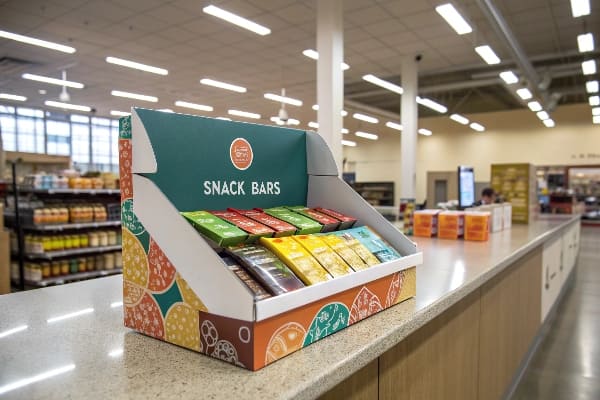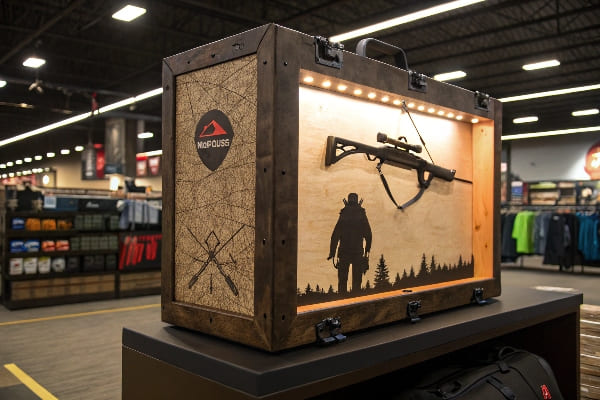A product can be great, but if shoppers never notice it, it sits and gathers dust. I once lost an entire order that way before I learned a simple fix.
A display box is a purpose-built package that lets the product travel safely, pop open fast, and stand on a shelf as its own mini shelf, so goods get seen and sold.

Good packaging earns space. Great packaging earns a stare. Stay with me and I will show how one small change can lift your sell-through rate and spare you the heartbreak I felt on that forgotten launch.
What is a retail display box?
I have watched buyers walk past plain cartons all day, yet stop cold when color and structure shout “pick me.” The gap hurts when you pay listing fees.
A retail display box is a pre-printed carton scored to fold into a self-contained countertop or aisle unit that ships product and acts as instant advertising.

How the retail box does two jobs
Retail asks speed and clarity. My Chicago client wanted crossbow wax1 at every checkout before deer season. We built one pack that did shipping and selling. Below is what makes that happen:
| Feature | Shipping Role | Selling Role |
|---|---|---|
| Double-wall back panel | Stops crush | Gives height for brand logo |
| Tear-away front lip | Holds items tight | Creates open window |
| Pre-scored inserts | Locks product | Keeps tidy rows |
| Spot gloss print | Scuffs resist | Catches store light |
The dual role saves labor on the store floor. Staff rip away one perf, lift the cover, and the goods face forward. My factory’s three lines time this tear-strip to the millimeter, because if it sticks, the clerk will leave and the box never opens. That single failure can kill a launch day. When you test the sample—always test hard—drop it, shake it, then open it. If it still looks neat, you win the space battle. The cost of an extra test sheet is nothing next to a missed season.
What is another name for a display box?
I keep a list of trade terms because buyers love jargon. One name can unlock a requisition form; another can confuse accounting.
A display box is also called shelf-ready packaging (SRP), retail-ready packaging (RRP), or counter display unit (CDU) depending on region and store policy.

Why names matter more than you think
I learned in Toronto that “SRP” sped approval because the chain’s internal guide used that exact label. In Texas the same item stalled until we wrote “PDQ tray,” which the buyer’s system recognized.
| Term | Common Region | Typical Size | Main Use |
|---|---|---|---|
| SRP (Shelf-Ready)2 | Europe, Canada | Small to medium | Fast shelf replenishment |
| RRP (Retail-Ready)3 | UK grocery | Medium | Mixed goods in pallets |
| CDU (Counter Unit) | Australia | Very small | Impulse buys |
| PDQ Tray4 | USA big-box | Medium | Seasonal promos |
When you pitch, mirror the buyer’s language. It shows you read their spec book and saves you from compliance rejects. My quote templates now hold every variant, so I swap labels in seconds. This tiny word tweak once cut a two-week approval loop down to a single afternoon and secured a 50,000-unit reorder before the tooling even cooled.
What are the benefits of custom display boxes?
Stock boxes are quick, but they tell no story. I learned that when my plain white mock-up left my crossbow client yawning during a video call.
Custom display boxes boost brand recall, use space perfectly, protect delicate shapes, and raise perceived value, which together lift sell-through and repeat orders.

The four boosts that pay the bill
A crossbow string gel tube slides on shelves if the hole in the insert is wrong by one millimeter. Custom cuts stop that slip. Benefits run deeper:
| Benefit | How It Works | Result |
|---|---|---|
| Brand recall5 | PMS-matched inks and embossed logo | Shoppers link color to brand fast |
| Space fit | Tailored foot-print for shelf planogram | Store accepts product without reset |
| Product safety6 | Die-cut cradle hugs shape | Zero returns from leaks or dents |
| Value signal7 | Matte-laminated panel feels premium | Higher price tolerance |
When I switched Barnett’s lubricant kit from a plain tray to a branded wrap-around design, unit margin rose 12 % because shoppers believed the kit was “new” even though formula stayed. The extra margin paid back tooling after one quarter. Custom also deters copycats; a hard-to-replicate structure keeps grey-market goods out, protecting long-term volume.
What is the purpose of a display case?
People often mix up boxes and cases. A case is not just bigger; it tells a different story. I had to learn this when a museum buyer asked for UV acrylic, not cardboard.
The purpose of a display case is to protect and showcase valuable or fragile items while allowing full visibility, often for long-term presentation rather than quick retail turnover.

Protection first, sales second
My cardboard lines rarely build acrylic, yet I advise clients on both so they choose right. A display case serves these core purposes:
| Purpose | Example | Key Feature |
|---|---|---|
| Physical security8 | Signed baseball | Lockable panels |
| Environmental shield9 | Vintage bow sight | UV-blocking walls |
| Controlled display angle10 | Limited-edition knife | Adjustable mount |
| Permanent branding | Museum gift store | Etched logo plates |
Cases stay put; boxes move on. If your launch needs rapid sell-through, pick a shelf-ready box. If you are guarding a prototype at a trade show, pay for the case. I once sent a sample crossbow in a clear case to Las Vegas. It survived rough handling, grabbed videos on social feeds, and came home without a scratch. That single case became a prop on every investor call afterward. The ROI dwarfed its cost because the case turned the prototype into a hero piece.
Conclusion
Display boxes move products fast; cases guard treasures for the long haul. Choose the right tool and watch your sales space work harder.
Explore this link to discover top-rated crossbow wax options that can enhance your retail offerings and meet customer needs. ↩
Explore this link to understand how SRP packaging can enhance your product’s marketability and streamline replenishment processes. ↩
Discover the benefits of RRP packaging and how it can optimize your product’s display and sales in grocery environments. ↩
Learn about PDQ Trays and how they can boost your seasonal promotions and sales in big-box stores. ↩
Understanding brand recall can help you enhance your marketing strategies and improve customer loyalty. ↩
Exploring product safety can reveal its critical role in building trust and reducing returns, essential for business success. ↩
Learning about value signals can help you position your products effectively and justify higher prices to consumers. ↩
Explore how display cases enhance physical security for valuable items, ensuring they are protected and showcased effectively. ↩
Learn about the importance of environmental shields in display cases to preserve the integrity of your collectibles from damage. ↩
Discover how adjustable mounts in display cases can enhance visibility and presentation of items, making them more appealing to viewers. ↩

